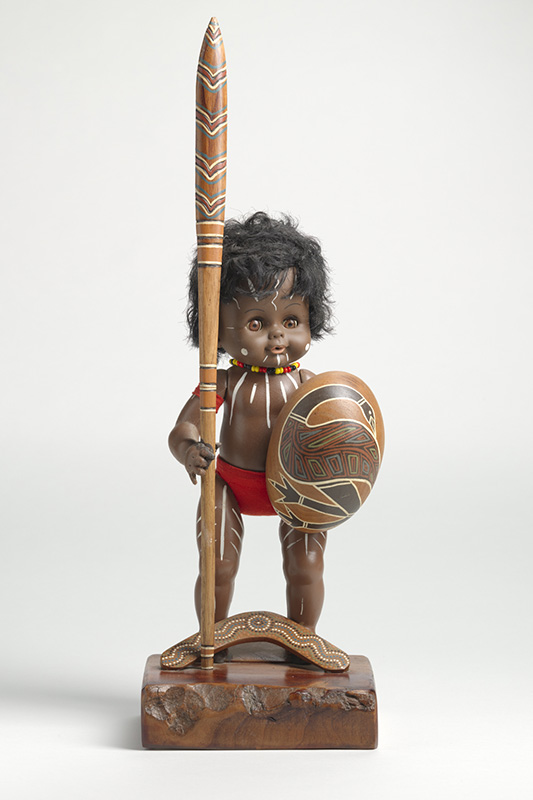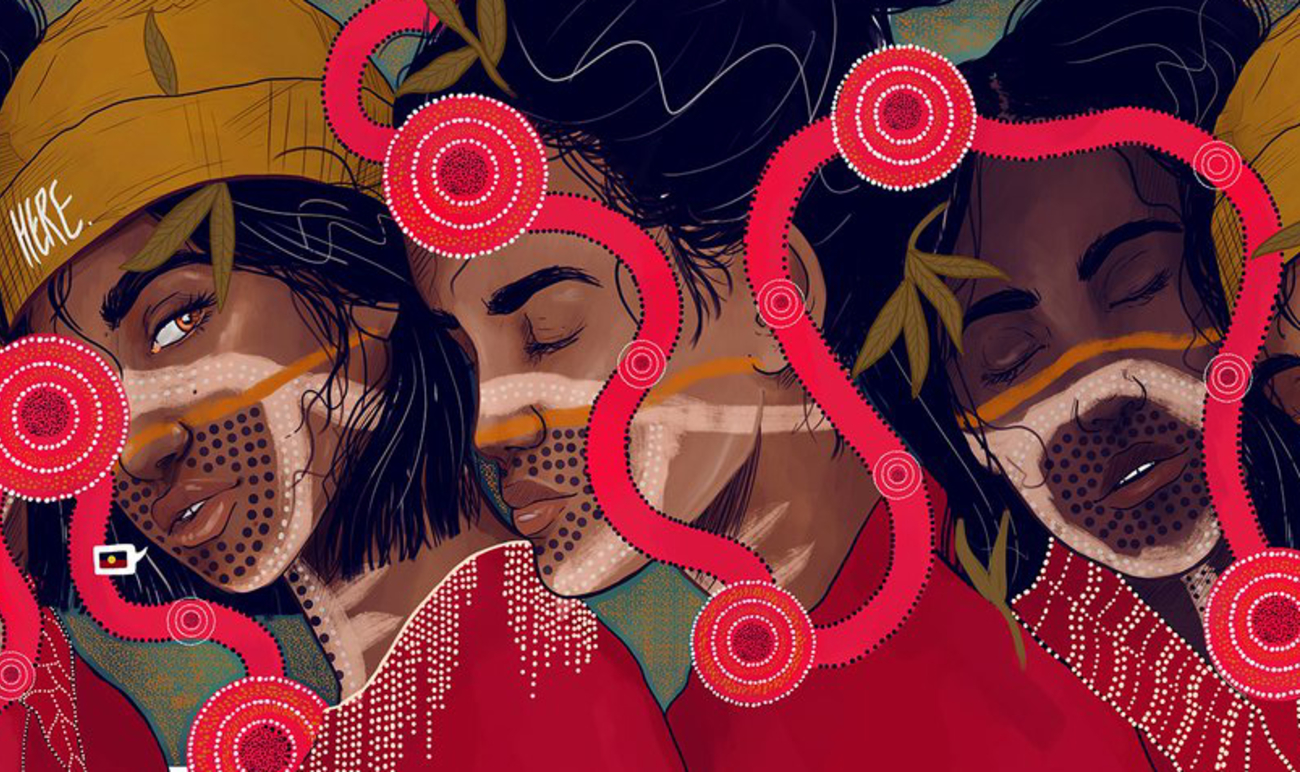In 2016, AIATSIS acquired Kerry Reed-Gilbert's extensive collection of decorative domestic items that depict Aboriginal people or use Aboriginal motifs. The collection includes plates, figurines, badges, ashtrays, prints, and velvet paintings. Accumulated over decades, Reed-Gilbert holds a deep affection for the Aboriginal people represented in these objects, who have elsewhere been described as stereotypes.
The following exchange between Reed-Gilbert and AIATSIS Curator, Sally Brand, is a response to Dr. Liz Conor’s essay 'Aboriginalia' and the politics of Aboriginal kitsch published in The Conversation in March 2017. The Conversation was first offered this piece for publication; however, their charter only permits contributions by PhD candidates and researchers and academics with a university or research institution affiliation. This exchange is published here for the first time in conjunction with a new display of The Kerry Reed-Gilbert Collection at AIATSIS. Read more about the display here.

Dolly made by Laddie Timbery. AIATSIS (AO R02181 - ATS 1078_063).
Dolly made by Laddie Timbery. AIATSIS (AO R02181 - ATS 1078_063).
Kerry Reed-Gilbert (KRG): My mother gave me my first two prints way back in the 1970s and I have been collecting ever since. I am very proud of my collection. Every piece I bought was beautiful and I am happy to call it mine. I remember one day I opened up one of my parcels and the image on the dish was a campfire scene with a family. The significance of this image for me as an Aboriginal woman is one of pride and honour. I belong to this Mob. In my hand I held a spiritual and cultural link to the past.
Sally Brand (SB): There is a common assumption that Aboriginal people have had no involvement other than being depicted in these objects. Conor briefly mentions Bill Onus, the Yorta Yorta activist and businessman behind the highly successful Aboriginal Enterprise in Melbourne in the 1950s, as well as the more recent repurposing of Aboriginalia by contemporary artists Destiny Deacon and Tony Albert, but these seem tangential to her central argument. Conor asks, ‘Is it appropriate to now own such objects in a knowing, retro-trashy way – when racism is still alive and well in Australia?’ How do you respond to this?
KRG: I feel very angry and find her assumptions insulting. She attempts to convince Aboriginal people and others to think the same way that she does that we shouldn’t like Aboriginalia or have anything to do with it. How dare she! I know there are others like her, and I just want to say that they have no right to speak for us and they can’t determine what we should or shouldn’t like or love. I recently saw a friend of mine hide an ashtray that had a beautiful picture of an Old Uncle dressed as a stock hand. How sad it is that we are made to feel ashamed of our cultural objects.
It is important to note that I take offence at the exclusion of our response as I believe my existence and experience as a Aboriginal woman makes me more than qualified. I believe this statement is a further example of how Aboriginal peoples life and experience are devalued.

Man (wall decoration). AIATSIS (AO R02181 - ATS 1078_162)
Man (wall decoration). AIATSIS (AO R02181 - ATS 1078_162)
SB: Your description of Aboriginalia as ‘our cultural objects’ acknowledges the shared legacies of these items. No matter how you feel about them, they are undeniably objects of this country.
KRG: Some people think there is nothing Aboriginal that can be seen as good or beautiful in the world of Aboriginalia. I believe that this is the view Conor is spreading. These are absolutely objects of this country, not objects of disgust. The majority of us love them. One of my most significant items is my warrior doll made by Laddie Timbrey from Huskisson on the New South Wales South Coast. My warrior doll has moved with me from one house to another and travelled many kilometres and always held pride of place in my home. He was always one of the first images a person could see when they walked in my door.
SB: In 2017, Mutti Mutti/Yorta Yorta and Boon Murrung artist Maree Clarke exhibited a recreation of her grandmother’s lounge room on Manatunga Reserve around the time of the 1967 Referendum. Using hologram technology, Clarke presents a room of empowering and comforting memories, full of portraits of Aboriginal men on velvet, plates and wood panels. They stand as strong, proud guardians.
KRG: Clarke’s artwork is a classic example of how our elders loved and cared for these items because they represent us as a people, past and present. There is much sadness for us because of this academic propaganda that makes some Aboriginal people feel shamed to have these things. I find that troubling. Aboriginal people should not be made to feel shamed to care for and treasure these objects. We are emotionally invested to them and the people they depict. What upsets me most is the idea we can’t have a beautiful picture of a naked Black woman painted on velvet because it’s said by people like Conor that Aboriginal women are only seen as sexual objects to white men. How insulting is this? We, as women are as beautiful as any woman of this world. We are very proud of our beauty.

Woman (wall decoration). AIATSIS (AO R02181 - ATS 1078_156)
Woman (wall decoration). AIATSIS (AO R02181 - ATS 1078_156)
SB: What do you think of the idea for Aboriginal Australians to ‘recast’ Aboriginalia?
KRG: Each time I hear a non-Aboriginal person say ‘Aboriginal people need to have a discussion about this issue or that issue’ I get angry. I don’t need you people to tell me what I need to have a discussion about. And then deny us a right of response as what clearly happened here with Conor and the academic world. We don’t need your twisting and turning our world into innuendos and disgust. We are masters of our own destiny and we will decide what we see as being culturally right for us. I believe these objects represent who we are as people, from then to now. Each piece represents Aboriginal Australia and we will own them.
Further reading
Conor, Liz. ‘‘‘Aboriginalia’ and the politics of Aboriginal kitsch’, The Conversation, 3 March 2017.
Franklin, Adrian, Walter, Maggie, & Moreton-Robinson, Aileen (2012) Repositories of Recognition? Aboriginalia & The Inclusion of Aboriginal Culture in the Branding of Australia. In Franklin, Adrian & Maxwell-Stewart, Hamish (Eds.) The Research Life of Arts Objects. UniPrint, Sandy Bay, Tasmania, p. 11.
Brand, S. 2018. ‘Aboriginalia: Conversations and connections’. Tony Albert: Visible. Brisbane, Qld: Queensland Art Gallery – Gallery of Modern Art.
Comments [now closed]
Liz Conor replied on Mon, 16/07/2018 - 14:56
I'm mortified that I assumed in my Conversation article that white consumption of these objects is the same as Aboriginal consumption of them. I should have been aware these objects were often cherished by Aboriginal people who felt a personal connection to them and celebrated by them. I'm devastated to have insulted this longtime collector and curator, Wiradjuri Elder Kerry Reed-Gilbert and embarrassed as a researcher not to have been aware of her collection and got in touch with her to include her perspective. The editor of The Conversation will include a link to this article with mine. Truly sorry to have offended.
Kerry Reed-Gilbert replied on Mon, 30/07/2018 - 13:31
Thank you Liz and thank you for acknowledging the wrong that had eventuated from your paper. That is an important step in making things right. Too often we see our cultural objects being crucified by good meaning non-Aboriginal people with no clear understanding of our cultural obligations and inclusion of these objects into our world both spiritually and culturally. This is a learning journey for us all - for Us Mob Aboriginal people that when non-Aboriginal people make a statement that is not right, that does not fit with us as Aboriginal people we need to find a platform for your/our voice to be heard the same as I have done hear. (Thanks Sally and AIATSIS) To Liz and other non-Aboriginal people we are always willing to share the journey with you but first you must be invited to share it and that means yarning up with Mob. Then write your reports but don't leave us out so you can become the expert. In Unity Aunty Kerry Reed-Gilbert


